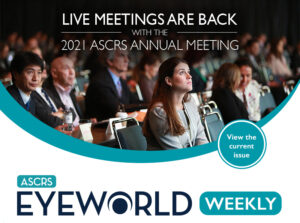Cholesterol-lowering gene linked to risk of cataract development
Researchers conducted large-scale genotyping and exome sequencing using the UK Biobank to better understand the effects of long-term statin use on cataract risk. What they found were common genetic variants that mimicked the cholesterol lowering of statins, though people were not taking statins, in more than 402,000 people. These individuals had a higher risk for developing cataract and having cataract surgery. Additionally, the researchers reported finding rare genetic mutations in 169,172 people that mimicked statin treatment and was linked to a nearly 5 times increased risk of developing cataracts.
Study: Structure, size of individual’s visual cortex affects visual potential
Researchers from the NYU Center for Neural Science and its Department of Psychology published a study that correlates the size of the primary visual cortex and the amount of brain tissue used for processing visual inputs with how well an individual sees. According to the university’s press release about the study, which is published in Nature Communications, “individual variation in the structure of the human visual brain is linked to variation in visual functioning.” The investigators used functional MRI to map the primary visual cortex in more than two dozen volunteers, measuring the amount of tissue dedicated to visual processing with input coming in from different areas of their field of view, according to the press release. Quality of vision (contrast sensitivity) at these different points of view was then assessed. The difference in visual cortex surface area predicted measurements of the individual’s contrast sensitivity, the university reported.
Purkinje reflections for capsulotomy centration
Centricity Vision announced publication of a clinical study that describes how Purkinje reflections at patient fixation could be a marker for capsulotomy centration. The study, published in the Journal of Cataract & Refractive Surgery, described how patient fixation can be “hindered during surgery because of anesthesia or light sensitivity.” As such, the researchers demonstrated the relationship between P1 and P4 Purkinje reflections preop and how this can be recreated intraoperatively if fixation is difficult during surgery. According to the paper, “the final position of P1 and P4 relative to one another at fixation is invariant in a given patient, but there are variations among patients. Knowledge of the P1 and P4 relationship can be used as a surrogate sign of patient fixation to assist in capsulotomy centration,” the authors concluded. The study used the Zepto precision pulse capsulotomy device (Centricity Vision) to perform an automated capsulotomy centered at P1, but the authors noted that other automated capsulotomy devices and manual capsulorhexis could be used with “incorporation of a capsulotomy centration point that is guided by the SFCSCLR.” The press release from the company stated that the study underscores the importance of centering the IOL on the patient’s visual axis with a 360-degree capsular overlap for lens positioning and stability.
Possible new therapeutic approach to treat retinitis pigmentosa
New research is leading to a better understanding of the molecular mechanisms involved in the structural defects observed in the photoreceptor cells in some patients with retinitis pigmentosa. According to a news release from the University of Geneva, researchers identified the essential role played by a molecular zipper formed by four proteins. Without this zipper in some RP patients, cell death occurs. The researchers hypothesized that a future therapy could involve injecting the necessary protein into patients with certain types of retinitis pigmentosa and restoring function of the molecular zipper to maintain structural integrity that could prevent the photoreceptor cells’ death. This approach, according to the press release, is already being researched.
ASCRS news and events
- ASCRS Summer Meeting: Register for the ASCRS Summer Meeting to get a “Taste of ASCRS”—its focused, anterior segment CME and its experience—August 19–21, 2022, in Nashville, Tennessee.
- Beyond 20/20: The full 4-episode, CME program for Beyond 20/20: An ASCRS Series in Modern Refractive Surgery and Presbyopia Therapy is now available on demand.
- ASCRS Satellite CME: Six complimentary CME resources are available online here.
- New issue online: Read the June issue of EyeWorld.
Research highlights
- The economic, clinical, and social outcomes of simple limbal epithelial transplantation (SLET) compared to cultured limbal epithelial transplantation (CLET) were compared in a comprehensive literature review and survey of eye surgeons. Overall, the anatomical success of SLET in adults was similar to that of CLET (72.6% and 70.4%, respectively), and it was more successful in children (77.8% vs. 44.5%), the authors reported. In the questionnaire, 99 surgeons reported performing SLET on 1,174 patients. They said that SLET was more cost effective compared to the culturing technique required by CLET. Economic analysis estimated the savings of SLET to be $6,470.88 for adults and $6,673.10 for children, which the authors equated to be about 10% of the cost of CLET for adults and 8% of the cost for children. The authors concluded that “SLET offers a more accessible and financially attractive alternative to CLET to treat limbal stem cell deficiency.” This research is published in the British Journal of Ophthalmology.
- A retrospective, multicenter study (31 institutions in Japan) evaluated the incidence and causative pathogens of endophthalmitis after vitrectomy during a period of strict mask wearing due to COVID-19. Overall, the incidence of post-vitrectomy endophthalmitis was significantly lower pre-COVID, with 18 endophthalmitis cases out of 16,568 surgeries pre-COVID (0.11%) and 31 cases out of 14,929 surgeries in the during COVID/mask-wearing period (0.21%). In the pre-COVID period, 4 of 18 eyes were culture positive (all the Staphylococcus family) compared to 9 out of 31 eyes being culture positive (4 cases related to oral commensals, including Streptococcus). The authors reported that Streptococcus species are “very rare in endophthalmitis after vitrectomy.” The authors stated that it’s important for physicians to be aware of this higher incidence of post-vitrectomy endophthalmitis during mask-wearing periods. This research is published in the British Journal of Ophthalmology.
- YUTIQ (fluocinolone acetonide intravitreal implant, EyePoint Pharmaceuticals and Ocumension Therapeutics) received new drug approval in China for non-infectious uveitis affecting the posterior segment. This product was approved by the U.S. FDA in 2018.
Product news
- YUTIQ (fluocinolone acetonide intravitreal implant, EyePoint Pharmaceuticals and Ocumension Therapeutics) received new drug approval in China for non-infectious uveitis affecting the posterior segment. This product was approved by the U.S. FDA in 2018.
This issue of EyeWorld Weekly was edited by Stacy Jablonski and Liz Hillman.
EyeWorld Weekly (ISSN 1089-0319), a digital publication of the American Society of Cataract and Refractive Surgery (ASCRS), is published every Friday, distributed by email, and posted live on Friday.
Medical Editors: Sumit “Sam” Garg, MD, Chief Medical Editor; Rosa Braga-Mele, MD, Cataract Editor; Clara Chan, MD, Cornea Editor; Nathan Radcliffe, MD, Glaucoma Editor; and Vance Thompson, MD, Refractive Editor
For sponsorship opportunities or membership information, contact: ASCRS • 12587 Fair Lakes Circle • Suite 348 • Fairfax, VA 22033 • Phone: 703-591-2220 • Fax: 703-591-0614 • Email: ascrs@ascrs.org
Mention of products or services in EyeWorld Weekly does not constitute an endorsement by ASCRS.
Click here to view our Legal Notice.
Copyright 2022, EyeWorld News Service, a division of ASCRSMedia. All rights reserved.




